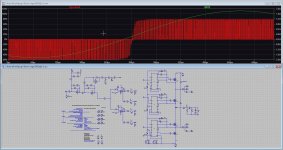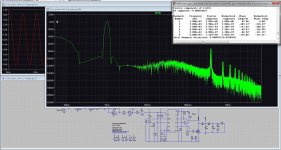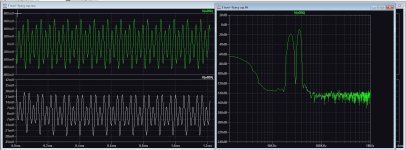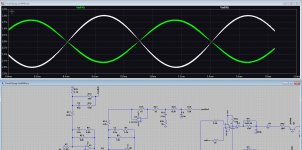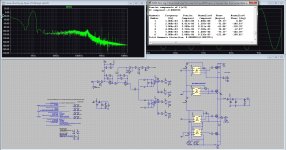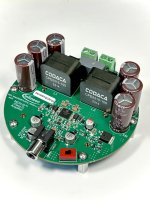it was the absolutely best sounding inductors we could find. However, made EMC a challenge: lots of stray capacitance
Did you release any amplifiers with an air core inductor? How do you isolate & contain the magnetic fields?
High switching frequencies can make air core inductors a more sensible solution, but the high frequencies can cause other issues.
At high frequencies timing jitter can be an issue & 1/f noise in the clock buffers can make it worse.
Did you review this paper?


High switching frequencies can make air core inductors a more sensible solution, but the high frequencies can cause other issues.
At high frequencies timing jitter can be an issue & 1/f noise in the clock buffers can make it worse.
Did you review this paper?
I designed a board for a powered speaker and it has a TPA3116 amplifier as per the schematic below. However, I get very little power out of it. The power draw from the PSU is about 1.4W.
I tested it using the output from a phone, so I'm thinking maybe the signal level is too low. Does it need a preamplifier to drive it?
I tested it using the output from a phone, so I'm thinking maybe the signal level is too low. Does it need a preamplifier to drive it?
Attachments
Hi.I connected IRAUDAMP7S. I am happy with the result.It is very powerful. I measured temperature of TIP41C and on the right one is about 78celcius and left is about 55celcius degree. Do you think there is a problem? And anyone knows input impedance of the amp? Is it 3K3 ?

Share class D inductor application noteWhat kind of inductors are in use of the modules of Purifi Audio and the mentioned amp
Attachments
Building a class d amp is not easy, feedback needs special attention and also pcb design and dead times.
Best is use a driver ic for that.
I have play some, with it, can be good designed with a lineair model in spice. (simulates high switching frequencies).
But now busy with helping someone who is sick and will die. I supporting.
Best is use a driver ic for that.
I have play some, with it, can be good designed with a lineair model in spice. (simulates high switching frequencies).
But now busy with helping someone who is sick and will die. I supporting.
Attachments
Which of the current IC would you recommend to get the highest current out? I do not know an IC which has a high switching capability to drive more than 100W (real Watts) without either quality or heat issues.Best is use a driver ic for that.
Going back to another posting with the swedish paper, I wonder why the need GaN-Transistors for this? And I wonder what the purpose of the paper actually is, since these amplification stats have been introduced very much earlier already for higher currents. Maybe it is because of audio (?)
However I was involved in a project in 2008 when I performed high precision synchronisation of power amplifiers for particle beam accellerators were used GaAs-Transistors to perform switching in the range of 4GHz and higher. Actually on-times had been around up to some 0.5 to 2 us.
Sad to hear that. Went through that too some time ago and it totally stopped me from making music, doing work and being active in handcrafting. But: Times change and strength comes back to our minds!But now busy with helping someone who is sick and will die. I supporting.
The best sounding class D inductor currently being made.
Core mateiral
Core mateiral
- Manganese zinc ferrite core(MnZn) with wide temperature, high frequency, and low loss.
- The EP shape magnetic core with excellent magnetic shielded ability to reduce electromagnetic interference.
- coil is wound with oxygen-free copper enameled flat wire, with excellent conductivity and high-speed signal transmission ability, which will not cause distortion at the output of the amplifier.
Coil2021, what is the max voltage rating of your coils? Planning an electrostatic headphone amp which would directly swing 500V or more (ideally up to 800 or 900) without step-up transformers, using a GaN Systems eval board set. Problem is finding/tuning an appropriate modulator.
I have never ventured into Class D or H power amps. still with A & A/B. Wondering how they compare in audio systems. A few years ago I bought a Panasonic 5.1 surround system,(now consigned to the loft!). The output stages claimed to be 100W/ channel, from the appearance they could have only been Class D. The supplied connecting wire to the speakers was bell wire, even to the sub woofer, an 8 inch pressed steel driver, I was not impressed with the performance of the system. A great disappointment, as I have a great respect for Panasonic / Technics products. Would appreciate others' experiences .
All will be get right. Now I fight Lyme.Sad to hear that. Went through that too some time ago and it totally stopped me from making music, doing work and being active in handcrafting. But: Times change and strength comes back to our minds!
I had the same bias as you before, until I heard the well designed TPA3255 class D amp, it actually sounded better than all the class ab amps I've heard. I can listen to it all day, enjoy comfortable sound without fatigueI have never ventured into Class D or H power amps. still with A & A/B. Wondering how they compare in audio systems. A few years ago I bought a Panasonic 5.1 surround system,(now consigned to the loft!). The output stages claimed to be 100W/ channel, from the appearance they could have only been Class D. The supplied connecting wire to the speakers was bell wire, even to the sub woofer, an 8 inch pressed steel driver, I was not impressed with the performance of the system. A great disappointment, as I have a great respect for Panasonic / Technics products. Would appreciate others' experiences .
I have succesfully figt late lyme. antibiotics did work.
So again I am started with the electronics. Have no ready build a pcb cnc router.
I go do class d wh has current feedback, and below 1Khz it has voltage feedback, reason is current feedback do
not well in low frequencys. I use multilevel system.
Making goodFeedback is quite a long pad, when have extreme low distortion, amp is unstable and square test is bad, when let it have higher
distortion it does a lot better, so need to make some step between. still when use capacitor current feedback I have a very nice triangle output
who do have dynamic adjustment in feedback path, so things did go a lot better.
Pics are feedback before and after low pass with triangle generator in trhee level flying cap. See the double tone test is very clean, no bad distortions.
regards
So again I am started with the electronics. Have no ready build a pcb cnc router.
I go do class d wh has current feedback, and below 1Khz it has voltage feedback, reason is current feedback do
not well in low frequencys. I use multilevel system.
Making goodFeedback is quite a long pad, when have extreme low distortion, amp is unstable and square test is bad, when let it have higher
distortion it does a lot better, so need to make some step between. still when use capacitor current feedback I have a very nice triangle output
who do have dynamic adjustment in feedback path, so things did go a lot better.
Pics are feedback before and after low pass with triangle generator in trhee level flying cap. See the double tone test is very clean, no bad distortions.
regards
Attachments
What happens if you dedicate it to a narrower spectrum of frequencies so that it only does SUB for example?
What means "pure analog Class D" (HiFi Rose calls it "class-AD") ? - go to
https://www.stereophile.com/content/hifi-rose-ra180-integrated-amplifier
https://hifirose.com/RA280
Are there schematics from ROSE released ?
P.S.: at whole interesting outline - go to
https://hifirose.com
https://www.stereophile.com/content/hifi-rose-ra180-integrated-amplifier
https://hifirose.com/RA280
Are there schematics from ROSE released ?
P.S.: at whole interesting outline - go to
https://hifirose.com
I happened to get my hands on a Boston acoustics Soundware XS subwoofer with the plate amplifier gone missing. So am trying to see if I can build a plate amplifier using this class D amp from Aliexpress. TPA3251 High Power HiFi Digital Amplifier Board with High Power Stereo 220WX2 Bridge 350W AP2202

This is meant to be a stereo amp with an option to bridge to connect to a subwoofer. When I connect the LFE from my Yamaha AV receiver to one of the RCA's on the amp board; it works perfectly. However, I am relying on the Yamaha AV receiver to cut off all the high frequency. If I were to connect my TV audio out then there is nothing to filter out all the high frequencies. Hence, thinking of adding a pre-amp board like this.

The low frequency output from this preamp board should connect to the amp at the XH2.54 3p audio input terminal shown by the red arrow.

I need some help to decide how I make this work.
1) The amp already has a potentiometer that acts as an on/off switch and volume control. If I were to add the preamp board should I remove this potentiometer on the amp and use only the volume control on the pre-amp board?
2) How do I switch on the amp without this potentiometer switch? There are 2 wires separate from the rest indicated by the yellow arrow which looks like they might be connecting the on/off jumper and if I short them the amp should remain switched on? Is there any way of knowing this for sure using a multimeter ?

Any help would be much appreciated. And please pardon my lack of knowledge. I have no background in electronics.
Many thanks.
This is meant to be a stereo amp with an option to bridge to connect to a subwoofer. When I connect the LFE from my Yamaha AV receiver to one of the RCA's on the amp board; it works perfectly. However, I am relying on the Yamaha AV receiver to cut off all the high frequency. If I were to connect my TV audio out then there is nothing to filter out all the high frequencies. Hence, thinking of adding a pre-amp board like this.
The low frequency output from this preamp board should connect to the amp at the XH2.54 3p audio input terminal shown by the red arrow.
I need some help to decide how I make this work.
1) The amp already has a potentiometer that acts as an on/off switch and volume control. If I were to add the preamp board should I remove this potentiometer on the amp and use only the volume control on the pre-amp board?
2) How do I switch on the amp without this potentiometer switch? There are 2 wires separate from the rest indicated by the yellow arrow which looks like they might be connecting the on/off jumper and if I short them the amp should remain switched on? Is there any way of knowing this for sure using a multimeter ?
Any help would be much appreciated. And please pardon my lack of knowledge. I have no background in electronics.
Many thanks.
no like the standard part with standard voltage, if high voltage inside need put the gasket, high temperature adhesive tape, sleeve.I have never ventured into Class D or H power amps. still with A & A/B. Wondering how they compare in audio systems. A few years ago I bought a Panasonic 5.1 surround system,(now consigned to the loft!). The output stages claimed to be 100W/ channel, from the appearance they could have only been Class D. The supplied connecting wire to the speakers was bell wire, even to the sub woofer, an 8 inch pressed steel driver, I was not impressed with the performance of the system. A great disappointment, as I have a great respect for Panasonic / Technics products. Would appreciate others' experiences .
Attachments
- Home
- Amplifiers
- Class D
- Class D Design Issues
